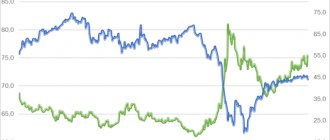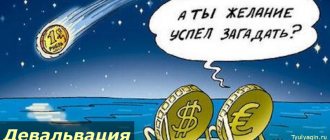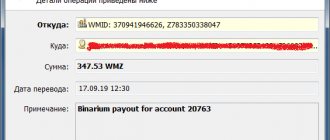Forecasts about the upcoming redenomination of the Russian currency worry fellow citizens, who associate the “cutting off of zeros” in 1997 with the subsequent default and devaluation of the ruble. Let's figure out what currency denomination is, why it is carried out, what negative and positive consequences it promises, and also remember the currency exchanges that took place in the 20th and 21st centuries in Russia and foreign countries.
What is a denomination in simple words?
I continue to talk about complex concepts in simple words, and today, considering the denomination, I will pay attention to its key features. In fact, this is a situation where the nominal value of a currency decreases after its hyperinflation and new denominations appear. The procedure is closely related to the reforms in the economic segment that are being carried out in the state. This is sometimes called "money cutting."
Denomination is more of a negative phenomenon for the inhabitants of the country; in simple words it can be explained as follows. A loaf of bread cost 5 USD, inflation for the year was 210%. Now bread costs 30 USD. The minimum currency was 1000 USD, but it became 10, and it is not enough even for this purchase.
By denomination the government, as it were, regulates the rise in prices; it is presented in a proportional ratio, for example 1000:
- A 5 thousand banknote turns into 5 rubles;
- loan of 100 thousand in 1000.
The situation most often occurs when the inflation rate for the year is over 200%, that is, it has entered the hyperinflation segment. These concepts should be closely considered together, and what inflation is and how to determine it after reading the article can be done by everyone.
Denomination: pros and cons
Let's consider the pros and cons of denomination for the national economy and the country's population.
Positive sides:
- increasing the convenience and speed of cash payments;
- reducing the number of bills in the buyer’s pocket;
- simplification of financial reporting for business and personal/family budget planning for citizens;
- improving the quality and degree of security of banknotes;
- reducing the costs of the central bank and financial institutions for transporting money
Negative sides:
- rounding prices towards increasing the cost of goods and services. Those. if the product cost 147 thousand rubles, and after the strongest “trimming of zeros” - 14.7 kopecks, then the price will most likely be rounded to 15 kopecks;
- it is difficult to get used to new banknotes and changed prices;
- exchanging more cash for less is psychologically perceived as government robbery
The consequences of denomination depend on its conditions and position in the country’s economy.
If “cutting off zeros” is carried out at a time of economic growth, after overcoming hyperinflation, is non-confiscating in nature and is accompanied by a powerful explanatory campaign, the process is painless and the positive effect outweighs the negative. Otherwise there is a high probability:
- panic among the population, causing excessive demand for foreign currency and certain goods;
- new rise in inflation;
- repeated depreciation of the denominated currency instead of strengthening
Reasons for denomination
First of all, these are government reforms, but the global cause is the financial crisis. If you look at countries that have faced crisis phenomena, in denominations the state briefly reduced the denomination of the currency and the prices of goods. Most countries were very uneasy. Economists and experts identify 2 groups of occurrence factors.
External ones include:
- global crisis, peg of the national currency to the dollar, euro;
- war with external enemies;
- loss of a number of territories.
Speaking about internal reasons, we can focus on the following:
- risky economic development strategy;
- conflicts within the country;
- natural or man-made emergencies;
- unstable political weather.
In order to understand the reasons for the depreciation of money as such, it is worth first finding out what devaluation is and for which countries it is typical.
Reform in the USSR 1961
In the USSR this was already the third such reform, after 1922 and 1947. When the ruble was redenominated almost 60 years ago, the party government called it “the most humane in history.” Ratio 10:1. An interesting aspect of the reform is that although the currency was changed, small 1, 2, 3 kopeck coins were left and their value did not decrease. Innovations did not affect 5, 10 and 15 kopeck coins. Those who saved in “metallic currency” were the winners. As part of the reform, the government issued a circular prohibiting the exchange of paper money for coins in banks.
Denomination in Russia 1998
You can clearly see how the denomination of money decreases. A dramatic depreciation of money in Russia was observed in 1998, when banknotes were replaced with fewer zeros. The coefficient was 1000:1, that is, a banknote of 50 thousand rubles turned into 50 rubles. The exchange could be made until 2003. The idea itself was not bad, but its incorrect implementation provoked a default: the ruble, as a national currency unit, depreciated by 2 times, although the monetary equivalent was changed.
Denomination in Belarus 2020
Belarus and its money also fell under such a reform. 10 thousand national rubles were equal to 1 ruble from July 1, 2020. This is not the first experience for the country; the first was in 1992, when “bunnies”, “squirrels”, “bisons” - whatever they were called - appeared. Just imagine: a zero was mentally added to the bill, and this was the reason that other money was officially introduced in 1994.
In the 2000s, three zeros were removed from “million dollar bills.” According to the 2020 reform (by the way, Alexander Lukashenko said 3 years earlier that new money had been printed and was in stock), new banknotes appeared: 5, 10, 20, 50, 100, 200 and 500 rubles, and eight coin denominations - 1, 2, 5, 10, 20 and 50 kopecks. 1 and 2 rubles are made in metal form.
Reform in the USSR 1961
Depreciated “Stalinist style” banknotes were exchanged without restrictions for new banknotes, in a ratio of 10:1, and 50 kopeck and 1 ruble coins were also put into circulation.
But during this reform, the ruble was devalued through a decrease in the gold content. Instead of the expected equivalent of 2.22 grams, the ruble contained the equivalent of only 0.98 grams of gold. Thanks to the planned economy, prices in state stores were kept at the stated level, but in collective farm markets, where private traders traded, the price of food tripled. The costs of this reform were overcome only after a few years
The process of denomination
The reform of the system takes place in stages, as a rule, over 6-12 months, while cash circulation in old banknotes is allowed during this time. I suggest you familiarize yourself with the main stages and their key features.
Stages of denomination and their aspects
| Stage | What's happening? |
| Decision-making | The government makes a decision and publishes it in the official press, specifying the dates for the reform. |
| Conducting economic examinations | The market and consumer power are studied and the denomination coefficient is determined, which is a multiple of 10. |
| Currency preparation | The Mint prints new money. |
| Gradual withdrawal of old banknotes from circulation | During collection, old money is confiscated and new ones, including coins, are issued. |
Transnistria (Transnistrian ruble, 2001, 1,000,000:1), Turkey (Turkish lira, 2005, 1,000,000:1), Zimbabwe (Zimbabwean dollar, 2008, 1,000,000:1) can easily be called world record holders for “currency cuts.” ).
Positive and negative consequences
We are primarily interested in the consequences of denomination for ordinary citizens.
Positive:
- Simplify calculations and increase speed. Agree, it’s easier and faster to count change when it doesn’t have 10 zeros.
- Reducing the physical quantity of banknotes in citizens’ wallets and store cash registers. Imagine a situation where you come to collect your salary with a cart or suitcase. And these are not stories made up by anyone. This was the case in Germany and Zimbabwe.
Negative:
- Panic. Let's remember 1998. The denomination passed, and a serious crisis began. Therefore, if the government announces another exchange, the main danger is the distrust of the population. They will begin to buy currency and expensive goods, triggering devaluation and inflation. In this case, a powerful awareness campaign is very important to mitigate the negative consequences.
- Rounding of price tags. Imagine that previously the product cost 570 rubles. With an exchange of 1,000:1, it will cost not 0.57 rubles, but, most likely, 60 kopecks.
- Psychological moments. At first, people may get confused in stores, and dishonest sellers take advantage of this. Or they will be afraid of not having time to exchange, then there will be queues at banks. Another danger is to spend more, because the price tags are small, and it seems that now you don’t have to limit yourself.
- There may be problems when making transactions at ATMs or paying online. They may simply not have time to reconfigure the software.
What to do with money during redenomination? First of all, don't panic. How many stories have I already heard from my friends, which are dollars for 150 rubles. bought it, and then a month later the rate dropped to 65, then they invested all the money in the car, and it immediately depreciated by 20% after leaving the dealership.
Secondly, carefully read or listen to the exchange rules. You may not have to go anywhere at all. Money will gradually go out of circulation by withdrawing it from trade.
Thirdly, I never tire of repeating the main rule of an investor and simply a financially literate person - diversification. Don't keep your savings in one basket.
Prospects for a new denomination in Russia
Recently, the media has been increasingly talking about a possible redenomination of the ruble in Russia, which could happen in 2020 or already in 2020; The latest news for each of us is not very comforting. On the one hand, calculations will become simpler, but on the other, there is a pressing question: will the state be able to keep prices rising and the ruble exchange rate against the dollar. Sanctions play a significant role in this process. So far, from those who are openly “For!” such a process is Vladimir Zhirinovsky, who proposes to carry out a denomination with a ratio of 10:1.
If this happens, the level of wages will change; and how much Yandex earns now can be found at www.iqmonitor.ru.
People often talk about two concepts in parallel: devaluation and redenomination, so what is the difference between them? The first is the depreciation of money: last year you could buy a set of rolls and sushi for 1000 rubles, but this year you could buy only half a portion of California rolls. Denomination provides for a reduction in prices through the issuance of new currencies in a reduced denomination. Both depreciation and “cutting” of the currency can provoke or manifest themselves as a consequence of stagnation - stagnation in economic development. In the USA it was the period of the 30s - the Great Depression. An indicative fact: the dollar was never officially redenominated. But this does not mean that the currency did not depreciate in some countries. The largest banknote is 500 euros, 100 dollars, which also indicates the distribution of roles in the global economic market.
To summarize, I will say: globally this can cure the economy, but with the right approach, but, as a rule, denomination devalues consumer power and default is inevitable. It is worth paying attention to the advantage of the situation: money that could have been obtained illegally is withdrawn from circulation and monetary settlements are simplified. There is no official data on when there will be denomination in Russia, but for some reason many people think that the “cut” money has already been printed and is lying in a warehouse, following the example of Belarus. If the ruble does not strengthen against the dollar, then perhaps the experience of 20 years ago will be repeated. I wish that the denomination, if it happens, will be painless and smooth, and that prices will indeed become lower, but at the same time the consumer power of each of us will not fall.
See also:
- How to make money out of thin air - the simplest and most effective ways
- Deposit capitalization - what is it? Instructions for choosing a deposit with replenishment and capitalization
Author Ganesa K.
A professional investor with 5 years of experience working with various financial instruments, runs his own blog and advises investors. Own effective methods and information support for investments.
What's Really Happening
In Russia in 2020 there are no prerequisites for default. This is a situation in which the state has huge debts, but does not have any resources to pay them off. This is what happened with Greece in 2010, and this is approximately the situation with Ukraine, which borrows huge sums from the International Monetary Fund. Today in Russia there are funds accumulated in the national welfare fund and significant reserves in gold and foreign currency.
The constantly growing dollar exchange rate of the ruble is not caused by the financial well-being of the United States, but by government policies and alarmists. With the economy at a standstill in quarantine, currency is being put on sale and the population is buying it in panic. This is how the federal budget is replenished, and the ruble mass is pulled out of the money boxes without much difficulty.
According to the latest news, the state has found the necessary funds to support the population during the quarantine period by raising the tax on large deposits and on funds still flowing offshore. So there was no need to resort to external borrowing.
Those who are still convinced of an imminent default should remember that Russia has virtually no external debt. Unlike the States, where it is the largest in the world and as of November 2, 2020 it was $23 trillion.
Differences between devaluation and inflation and stagnation
Devaluation, inflation and stagnation are three terms that characterize the deterioration of the economic situation of the state.
Despite the external similarity and interconnectedness, these economic processes are somewhat different from each other.
Differences from inflation
Devaluation is the process of making a national currency cheaper compared to others. Inflation is a decrease in the purchasing power of the national currency in the domestic market.
Thus, the main difference between economic processes is the nature of the reduction in the cost of public funds.
For example, in the event of devaluation on the international market, one Russian ruble can buy fewer US dollars than before. Inflation refers to a decrease in the quantity of goods, imported or domestic, that can be purchased for the same amount during the year.
Inflation and devaluation: is one possible without the other?
In economically developed countries, devaluation processes are not necessarily accompanied by inflation.
However, in developing economies, such as Russia, a strong devaluation can contribute to inflation and vice versa.
Difference between devaluation and stagnation
The stagnant financial situation is accompanied by a decline in the economy and a deterioration in the standard of living of citizens. Stagnation, of course, can cause inflation and devaluation of the national currency of the state.
Devaluation is a drop in the value of a government financial instrument compared to other currencies.
The concepts of devaluation and stagnation are fundamentally different and relate to different economic factors.
Why and how it is carried out
Any denomination pursues several very significant goals:
- reducing the cost of creating new money . Thus, banknotes of larger denominations are issued, which reduces the need to renew any small bills - they simply do not exist;
- simplification of calculations . For example, after completing the procedure, there is no need to count pennies, rubles, hundreds, and sometimes even thousands;
- identification of “gray” income . Citizens have to exchange all their money, otherwise it will soon lose its value. To exchange, she is forced to show all her income and savings;
- The country's currency is noticeably strengthening after the denomination.
The process starts after the government makes the final decision to carry out the denomination. At the same time, new banknotes are immediately put into circulation, and old ones begin to be withdrawn from circulation.
This process cannot be called fast. It takes weeks and sometimes months to complete a complete exchange of the old currency for the new one. Of course, money in bank client accounts changes automatically.
Most of the population is very difficult to bear such economic stress. Sometimes this process is carried out so difficult and long that it takes more than one month or even a year. In this case, each store sets special price tags: for example, you can buy a product for either 200 old rubles or 2 new ones.
How is the denomination procedure performed?
Currency reform is a long process and requires phased implementation:
- The government of the country makes a decision on the implementation of currency denomination.
- Financial calculations are performed. Based on the data obtained, proportions are selected according to which the denomination of the national currency will be reduced. In most cases, the chosen ratio is a multiple of 10. The largest denomination ratio was 1 trillion to 1, used in 1922 in Germany.
- New banknotes are being printed. Gradually, old money is removed from circulation, replaced by new ones according to the following algorithm - money that ends up in financial institutions through collection is removed and replaced by new ones. Next, the bank issues banknotes using new money.
By carrying out redenomination, the government of a country determines the date after which transfer to a bank or settlement using old money is no longer a legal process. During the transition period, each version of banknotes is used equally, but the value of goods is applied at the updated denomination.
Thus, if a person comes to the store and wants to buy bread for 10 conventional units, having old money in hand, he needs to pay 10,000 conventional units (if the denomination coefficient is 1000k1).
What are its reasons and goals
The state will never carry out denomination without reasons, if only because replacing all banknotes and coins inevitably involves large expenses. After all, you first need to design the format, design and economic denomination of the currency - and the work of designers and economists is now not cheap. Then you need to print and mint money in huge quantities, and then remove old banknotes and coins from circulation, ultimately sending them for destruction. All this is a colossal expense.
So what could be the reason for such a large-scale action? Only one: excessive depreciation of the currency, which undermines confidence both within the country and abroad. Hyperinflation of the national currency stimulates capital to “flee” to more stable currency formations such as the dollar, pound sterling, etc.
Suffice it to recall Belarus before denomination as an example: salaries were paid in the millions, the cost of an ordinary bun could reach 10 thousand or more thousand Belarusian rubles. The population, and especially large capital, invested massively in foreign currency, because no one could guarantee a stable exchange rate for the Belarusian “bunny”. Against the backdrop of hyperinflation, even the Russian currency, which is unstable by international standards, has gained popularity.
The goals of the operation are most often the following:
- Establishing capital's trust in the local money formation. The flow of investment increases, due to which banknotes are further backed - this significantly slows down inflation;
- Removing excess money supply from circulation, thereby reducing inflation;
- In the long term - savings, because you won’t have to print a lot of banknotes due to the constant rapid rise in prices;
- An increase in the speed of circulation of money, because the population has to “get out their hiding places” in order to avoid losses. According to Keynes, high velocity of circulation allows one to get by with less cash. When the government does not have to print a lot of banknotes, inflation decreases;
- Simplification of payments between citizens, enterprises, banks and the government of the country with other countries.










